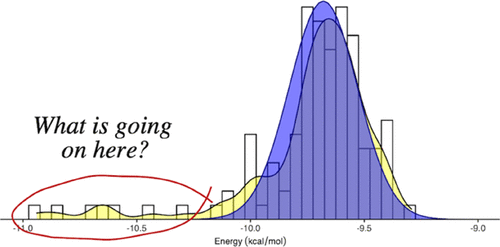当前位置:
X-MOL 学术
›
J. Chem. Inf. Model.
›
论文详情
Our official English website, www.x-mol.net, welcomes your
feedback! (Note: you will need to create a separate account there.)
Ensemble Simulations and Experimental Free Energy Distributions: Evaluation and Characterization of Isoxazole Amides as SMYD3 Inhibitors
Journal of Chemical Information and Modeling ( IF 5.6 ) Pub Date : 2022-05-04 , DOI: 10.1021/acs.jcim.2c00255 Shunzhou Wan 1 , Agastya P Bhati 1 , David W Wright 1 , Ian D Wall 2 , Alan P Graves 3 , Darren Green 2 , Peter V Coveney 1, 4, 5
Journal of Chemical Information and Modeling ( IF 5.6 ) Pub Date : 2022-05-04 , DOI: 10.1021/acs.jcim.2c00255 Shunzhou Wan 1 , Agastya P Bhati 1 , David W Wright 1 , Ian D Wall 2 , Alan P Graves 3 , Darren Green 2 , Peter V Coveney 1, 4, 5
Affiliation

|
Optimization of binding affinities for ligands to their target protein is a primary objective in rational drug discovery. Herein, we report on a collaborative study that evaluates various compounds designed to bind to the SET and MYND domain-containing protein 3 (SMYD3). SMYD3 is a histone methyltransferase and plays an important role in transcriptional regulation in cell proliferation, cell cycle, and human carcinogenesis. Experimental measurements using the scintillation proximity assay show that the distributions of binding free energies from a large number of independent measurements exhibit non-normal properties. We use ESMACS (enhanced sampling of molecular dynamics with approximation of continuum solvent) and TIES (thermodynamic integration with enhanced sampling) protocols to predict the binding free energies and to provide a detailed chemical insight into the nature of ligand–protein binding. Our results show that the 1-trajectory ESMACS protocol works well for the set of ligands studied here. Although one unexplained outlier exists, we obtain excellent statistical ranking across the set of compounds from the ESMACS protocol and good agreement between calculations and experiments for the relative binding free energies from the TIES protocol. ESMACS and TIES are again found to be powerful protocols for the accurate comparison of the binding free energies.
中文翻译:

集合模拟和实验自由能分布:异恶唑酰胺作为 SMYD3 抑制剂的评估和表征
优化配体与其靶蛋白的结合亲和力是合理药物发现的主要目标。在此,我们报告了一项合作研究,该研究评估了旨在结合 SET 和 MYND 结构域的蛋白质 3 (SMYD3) 的各种化合物。SMYD3 是一种组蛋白甲基转移酶,在细胞增殖、细胞周期和人类致癌作用的转录调控中起重要作用。使用闪烁邻近测定的实验测量表明,来自大量独立测量的结合自由能的分布表现出非正态特性。我们使用 ESMACS(具有近似连续溶剂的分子动力学增强采样)和 TIES(具有增强采样的热力学集成)协议来预测结合自由能并提供对配体-蛋白质结合性质的详细化学洞察。我们的结果表明,1-轨迹 ESMACS 协议适用于此处研究的配体集。尽管存在一个无法解释的异常值,但我们在 ESMACS 协议的一组化合物中获得了出色的统计排名,并且在 TIES 协议的相对结合自由能的计算和实验之间具有良好的一致性。ESMACS 和 TIES 再次被发现是用于准确比较结合自由能的强大协议。我们的结果表明,1-轨迹 ESMACS 协议适用于此处研究的配体集。尽管存在一个无法解释的异常值,但我们在 ESMACS 协议的一组化合物中获得了出色的统计排名,并且在 TIES 协议的相对结合自由能的计算和实验之间具有良好的一致性。ESMACS 和 TIES 再次被发现是用于准确比较结合自由能的强大协议。我们的结果表明,1-轨迹 ESMACS 协议适用于此处研究的配体集。尽管存在一个无法解释的异常值,但我们在 ESMACS 协议的一组化合物中获得了出色的统计排名,并且在 TIES 协议的相对结合自由能的计算和实验之间具有良好的一致性。ESMACS 和 TIES 再次被发现是用于准确比较结合自由能的强大协议。
更新日期:2022-05-04
中文翻译:

集合模拟和实验自由能分布:异恶唑酰胺作为 SMYD3 抑制剂的评估和表征
优化配体与其靶蛋白的结合亲和力是合理药物发现的主要目标。在此,我们报告了一项合作研究,该研究评估了旨在结合 SET 和 MYND 结构域的蛋白质 3 (SMYD3) 的各种化合物。SMYD3 是一种组蛋白甲基转移酶,在细胞增殖、细胞周期和人类致癌作用的转录调控中起重要作用。使用闪烁邻近测定的实验测量表明,来自大量独立测量的结合自由能的分布表现出非正态特性。我们使用 ESMACS(具有近似连续溶剂的分子动力学增强采样)和 TIES(具有增强采样的热力学集成)协议来预测结合自由能并提供对配体-蛋白质结合性质的详细化学洞察。我们的结果表明,1-轨迹 ESMACS 协议适用于此处研究的配体集。尽管存在一个无法解释的异常值,但我们在 ESMACS 协议的一组化合物中获得了出色的统计排名,并且在 TIES 协议的相对结合自由能的计算和实验之间具有良好的一致性。ESMACS 和 TIES 再次被发现是用于准确比较结合自由能的强大协议。我们的结果表明,1-轨迹 ESMACS 协议适用于此处研究的配体集。尽管存在一个无法解释的异常值,但我们在 ESMACS 协议的一组化合物中获得了出色的统计排名,并且在 TIES 协议的相对结合自由能的计算和实验之间具有良好的一致性。ESMACS 和 TIES 再次被发现是用于准确比较结合自由能的强大协议。我们的结果表明,1-轨迹 ESMACS 协议适用于此处研究的配体集。尽管存在一个无法解释的异常值,但我们在 ESMACS 协议的一组化合物中获得了出色的统计排名,并且在 TIES 协议的相对结合自由能的计算和实验之间具有良好的一致性。ESMACS 和 TIES 再次被发现是用于准确比较结合自由能的强大协议。


















































 京公网安备 11010802027423号
京公网安备 11010802027423号